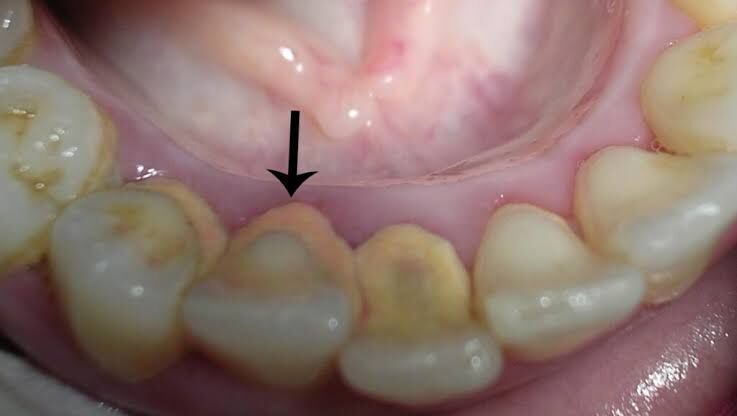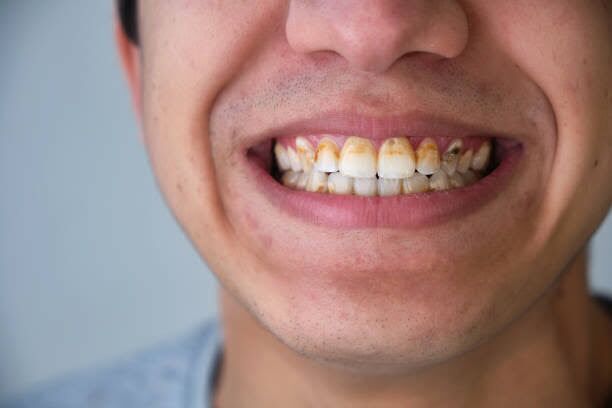Calculus Bridge: How to stop those yellow things from appearing on your teeth
Calculus bridge is those ‘yellow things’ you find on your teeth that are hard to remove even when you brush.
Many people have this on their teeth but not everyone knows how to get rid of it. So, here is all you need to know about calculus bridge and how to prevent and treat it.

What is Calculus Bridge?
When dental plaque, a sticky film forms on teeth due to activities like eating and drinking, is not effectively removed through proper brushing and flossing, it can mix with minerals present in saliva and transform into calculus. Unlike plaque, which can be easily eliminated with regular oral hygiene practices, calculus, also known as tartar, is a hard substance that cannot be effectively removed by brushing alone.
If you do not brush your teeth immediately after eating, you may notice a thin, sticky film forming on your teeth. This film is known as plaque and if it is not removed through regular brushing and flossing, it can harden into a substance called tartar, also referred to as calculus.
Plaque easily forms on teeth, particularly after consuming starchy or sugary foods and beverages. When the remnants of these foods mix with the bacteria in your mouth, acids are released, breaking down the carbohydrates. This combination of carbohydrates, acids and bacteria forms a colourless layer over your teeth, known as plaque.
This calcified dental plaque, also called calculus bridge, can develop within one to fourteen days of plaque formation, according to research.
Tartar poses a danger as it does not remain confined to the surface of your teeth. It can start spreading and progressing beneath your gumline, affecting the underlying tissue. The presence of tartar can lead to gum disease and tooth decay. It often appears as a stained, tan, or brown border along the edge of your teeth near the gumline.
ALSO READ: Blackhead removal: Effective techniques for maintaining a clearer skin
The severity of tartar buildup can vary from person to person, resulting in different appearances of a calculus bridge.

According to Gary Schlotterer, D.D.S., founder of Digital Dentistry at Southpoint in Durham, North Carolina, “A calculus bridge occurs when tartar or calculus builds up so much that it connects with the adjacent teeth and forms a solid ‘bridge’ of deposits. It often looks like a border of brown or tan along the edge of your teeth by your gum line.”
In more severe cases, the calculus bridge may extend further down into the gumline or cover a larger surface area of the teeth. To address this issue and prevent potential oral health complications, it is necessary to visit your dentist’s office for professional removal of the hardened calculus.
Regular dental check-ups and diligent oral hygiene practices can help maintain a healthy smile and prevent the formation of a calculus bridge.

Calculus Bridge effects
There are several calculus bridge effects, which include:
1. Gum disease
One of the most significant impacts of calculus bridge is the increased risk of gum disease. As calculus forms below the gumline, it irritates the gums and leads to inflammation and the onset of gingivitis. If left untreated, gingivitis can progress to periodontitis, a more severe form of gum disease that can cause gum recession, bone loss and tooth loss.
2. Tooth decay
Calculus bridge acts as a breeding ground for bacteria, creating an environment conducive to tooth decay. The bacteria produce acids that erode tooth enamel, which can cause cavities. Additionally, the rough surface of calculus provides an ideal surface for plaque accumulation and this further increases the risk of decay.
3. Bad breath
The presence of calculus bridge can contribute to persistent bad breath or halitosis. As bacteria multiply on the rough surface of calculus, they produce foul-smelling compounds and this results in chronic breath odour. Proper oral hygiene and regular professional cleanings can help eliminate the source of the odour-causing bacteria.
4. Receding gums
Receding gums, categorised as a type of periodontal disease, occur when the gum tissue starts to pull back or recede from the teeth. This recession leads to the exposure of more tooth surfaces and creates gaps or pockets between the gums and teeth. These spaces provide an opportunity for bacteria to accumulate and potentially cause further oral health issues.
5. Discoloration and stains
Calculus bridge often appears as a yellow or brownish discolouration on the teeth. This can significantly impact the aesthetic appearance of one’s teeth. The presence of calculus can also attract and retain stains from food, beverages and tobacco use, further compromising the appearance of teeth.
ALSO READ: Heart-healthy foods: 7 best foods for your heart
Calculus Bridge treatment
When it comes to oral health, calculus bridge can pose significant risks if left untreated. Calculus buildup on teeth surfaces can lead to gum disease, tooth decay, and other oral health complications.
To address these issues, dental professionals employ various treatment methods, collectively known as calculus bridge treatment.

Hence, calculus bridge treatment typically consists of the following procedures:
- Dental examination: The treatment begins with a comprehensive dental examination. The dentist assesses the extent of calculus buildup, evaluates the overall oral health, and identifies any additional oral health issues that may require attention.
- Scaling: Scaling is a key component when it comes to calculus bridge treatment. It involves using specialised dental instruments to remove the hardened calculus deposits from the teeth surfaces. The dentist or dental hygienist carefully scales the teeth, targeting areas where calculus has accumulated, including below the gumline.
- Root planning: In some cases, root planning may be necessary. This procedure smoothes the root surfaces of the teeth, helping to prevent the reattachment of bacteria and calculus. Root planing promotes gum tissue healing and reduces the likelihood of further calculus buildup.
- Oral hygiene education: As part of the treatment, dental professionals provide education on proper oral hygiene practices. This includes guidance on effective brushing techniques, the importance of regular flossing and the use of mouthwash. Patients are advised on maintaining a consistent oral hygiene routine to prevent future calculus formation.
- Follow-up care: After undergoing a calculus bridge treatment, patients are often scheduled for follow-up visits to monitor their oral health and ensure that calculus is not accumulating again. Regular dental check-ups and cleanings are recommended to maintain oral health and prevent future complications.
Calculus Bridge prevention
Here is how to prevent calculus bridge:
1. Maintain consistent oral hygiene
Establishing and maintaining a consistent oral hygiene routine is vital for preventing calculus bridge. This includes:
- Brushing twice a day: Brush your teeth thoroughly with a fluoride toothpaste at least twice a day for two minutes each time. Use gentle, circular motions to cover all tooth surfaces and pay attention to the gum line.
- Floss daily: Flossing helps remove plaque and food particles from between the teeth and along the gumline. Make it a habit to floss at least once a day, using proper flossing techniques.
- Use mouthwash: Rinse your mouth with an antimicrobial mouthwash after brushing and flossing. This helps reduce bacteria and plaque formation, promoting better oral hygiene.
2. Opt for proper brushing technique:
Using the correct brushing technique is essential for effective plaque removal and preventing calculus formation. Remember these tips:
- Angle the brush: Hold your toothbrush at a 45-degree angle towards the gumline. This allows the bristles to reach both the tooth surface and the gumline, removing plaque effectively.
- Gentle pressure: Apply gentle pressure while brushing. Aggressive scrubbing can damage the tooth enamel and irritate the gums.
- Brush all surfaces: Brush all tooth surfaces, including the outer, inner, and chewing surfaces. Do not forget to brush your tongue gently to remove bacteria and freshen your breath.
3. Regular dental check-ups and cleanings
Scheduling regular dental check-ups and professional cleanings is crucial for preventing calculus bridge. Your dentist can detect early signs of calculus formation and provide thorough cleanings to remove any existing deposits. Regular dental visits also allow for comprehensive oral examinations, enabling early detection and treatment of any potential oral health issues.

4. Limit sugary and starchy foods
Reducing the consumption of sugary and starchy foods can help minimise plaque formation and subsequent calculus bridge. These types of foods contribute to the growth of bacteria and acid production, increasing the risk of dental problems. Instead, opt for a balanced diet rich in fruits, vegetables, whole grains and lean proteins.
5. Quit smoking and tobacco use
Tobacco products stain the teeth, promote plaque accumulation and hinder the healing process of gum tissues. Quitting smoking and avoiding tobacco products can greatly improve your oral health and reduce the risk of calculus bridge formation.
ALSO READ: Is sinus infection contagious? All you need to know
ncG1vNJzZmivp6x7tLfAm5isoF6YvK57wpqjnK2cqsBurtGim6CdXw%3D%3D